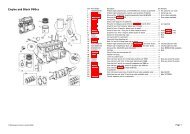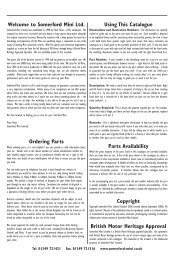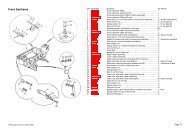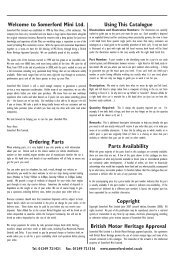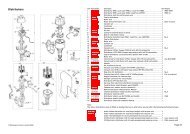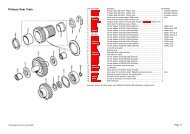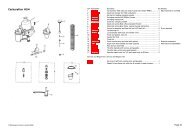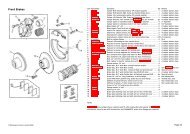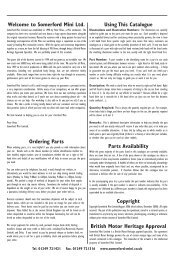Performance
Performance
Performance
- No tags were found...
Create successful ePaper yourself
Turn your PDF publications into a flip-book with our unique Google optimized e-Paper software.
04 TECHNICAL ADVICE www.moss-europe.co.uk London 020 8867 2020 Bradford 01274 539 999<br />
Engine Preparation<br />
This is a general guide to correct procedures and will apply, wholly or partly to all types of engine rebuild. However, before the engine rebuild can begin the engine needs to be stripped down, cleaned<br />
and examined, a procedure which many undertake with undue haste. During the strip down the following should be observed:<br />
1. Wait for the engine to cool properly before removing the cylinder head - this applies especially to aluminium type heads. The consequence of not waiting can result in a warped head.<br />
2. Mark the location (and, where applicable, orientation) of all major components especially valves, tappets, camshafts, pistons and rods, shell bearings by placing in clearly marked<br />
containers or racks.<br />
3. Before removing bearing caps (e.g. camshaft, con rod, main bearing), make sure they are clearly marked for position and orientation.<br />
Note: They must go back in the same position or on the same con rod and the right way round.<br />
Once stripped all parts should be thoroughly cleaned and inspected with specific attention to any areas of bad wear or damage e.g:<br />
1. Blown head gasket/burnt out valves - cylinder heads should always be thoroughly examined for cracks or distortion. Simply fitting a new gasket or valve is not the answer.<br />
2. Damaged piston/rings - always check the cylinders for wear and damage. If the pistons need replacing, a rebore or cylinder hone is almost certainly needed as well. Damage to<br />
bores often appearing at the limits of the piston ring travel may well be what dictates the need for a rebore or at least a professional hone.<br />
3. Badly worn crankshaft shell bearings - if the crankshaft is badly scored it must be reground to the next undersize. However, just as important are the con rod and main bearing<br />
housings that the shell bearings fit into. These are often overlooked and any wear or distortion in these areas will cause premature engine failure.<br />
Cleaning should include removal of all oil gallery plugs to enable thorough cleansing with brushes. Many parts can be re-used during the rebuild but the following items should always be replaced:<br />
1. All Gaskets And Seals. 2. Shell Bearings. 3. Timing Belts Or Chains. 4. Timing Belt/Chain Tensioners. 5. Piston Rings. 6. Oil Pump Drives. 7. All Major Fastenings Including Cylinder Head,<br />
Con Rod And Flywheel Bolts.<br />
Engine Rebuild<br />
The following highlight important procedures during the re-assembly of a modified engine:<br />
1. THOROUGHLY clean and check ALL parts - your engine’s worst enemy is dirt, even<br />
new parts may need cleaning. This includes the head and block and all oil galleries.<br />
2. ALWAYS fit new high quality gaskets and seals, ensuring all shafts and mating surfaces<br />
are free from burrs and defects. Use correct sealants or lubricants where necessary.<br />
3. LIBERALLY oil all internal parts during assembly. Use the special assembly lube or<br />
gear oil on cam lobes and tappet faces.<br />
4. ALWAYS replace cam followers when fitting a new camshaft.<br />
5. ALWAYS replace con rod, flywheel and cylinder head studs and bolts. All other<br />
fastenings should be checked for wear or damage and replaced as necessary. For high<br />
specification engines, race quality fastenings are available for most applications.<br />
6. CLEAN all threads and fastenings prior to fitment and use a good quality torque wrench<br />
on all critical components. Apply an anti-seize lubricant to all cylinder head fixings.<br />
7. IF you are fitting high lift cams, special pistons, or large valve heads, always carry<br />
out a dummy engine build and check valve to piston/block clearances. Machine<br />
piston crowns/valve pockets or block face as necessary.<br />
8. INCORRECT cam timing can severely reduce the power output so don’t overlook this<br />
area during assembly. Use adjustable cam pulleys or sprockets where available.<br />
9. CHOOSE compatible parts for your specific conversion. A full race specification<br />
head will be next to useless if fitted to a mild road stage engine. Modified camshafts<br />
and cylinder heads in particular should be chosen with care.<br />
10. UNLESS you know what you are doing, avoid over-lightening components. Reducing<br />
the weight of some parts may also reduce their strength to a critical level.<br />
11. ALWAYS have the engine assembly balanced - it will make a lot of difference to the<br />
smoothness and help maintain optimum reliability.<br />
12. DON’T forget the clutch - depending on the power increase, a suitable heavy duty or<br />
competition clutch assembly will be required.<br />
13. OIL And FILTER - the importance of using the correct specification of oil cannot be<br />
overstated. Please contact your local branch for advice.<br />
Most engine modifications should be followed up with a professional engine tune. Apart from<br />
emissions, the correct ignition timing and fuelling is paramount if you want the best return for all<br />
the expense and effort you have put in. Get these important settings wrong and you may loose more<br />
than just a bit of power. Over-fuelling (rich mixture) can result in excessive piston, ring and bore<br />
wear. Under fuelling (weak mixture) or retarded ignition can cause overheating problems. An ignition<br />
set with too much advance is likely to induce detonation or ‘pinking’ which, if left uncorrected, can<br />
shatter pistons and place excessive loads on the bottom end. You have been warned!<br />
Lastly, please check that your suspension and braking systems are adequate for the power<br />
increase you have achieved. A full range of optional equipment can be found further in the Moss<br />
Europe catalogue.



